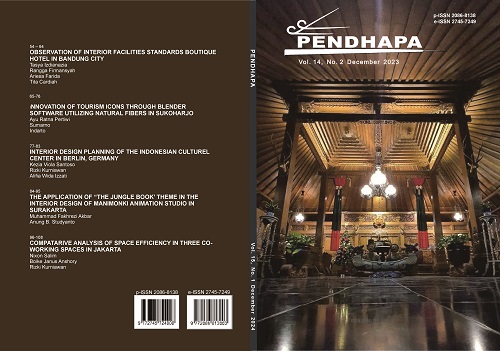Comparative Analysis of Space Efficiency in Three Co-Working Spaces in Jakarta
DOI:
https://doi.org/10.33153/pendhapa.v14i2.5194Abstract
In Indonesia, many companies operate from their own offices, whether in buildings or shop houses. However, co-working spaces have emerged since 2010, providing a viable alternative for entrepreneurs, particularly start-ups, freelancers, and small business owners who lack the capital to lease traditional office spaces. Co-working spaces have seen significant growth, especially in Jakarta, driven by the need for flexible and cost-effective workspace solutions. This research aims to examine the effectiveness of space utilization in co-working spaces in Jakarta, focusing on three specific locations: InHype.Co, UnionSpace, and Ko+labora. By employing both quantitative and qualitative methodologies, including surveys, direct observation, and interviews, this study provides a comprehensive analysis of space efficiency in these co-working environments. The findings reveal key factors that contribute to effective space utilization, including layout design, furniture functionality, and the balance between private and communal areas. The insights from this research are intended to inform entrepreneurs and designers on optimizing co-working spaces to enhance productivity and user satisfaction.
Downloads
References
Anastasia, E. (2018). A Design For Life. Griya Kreasi.
Bouncken, R. B., & Görmar, L. (2023). Coworking Space Definitions, Forms and Configurations. In R. B. Bouncken (Ed.), Awakening the Management of Coworking Spaces (pp. 13–23). Emerald Publishing Limited. https://doi.org/10.1108/978-1-80455-029-820231003
Colenberg, S., Jylhä, T., & Arkesteijn, M. (2021). The relationship between interior office space and employee health and well-being – a literature review. Building Research & Information, 49(3), 352–366. https://doi.org/10.1080/09613218.2019.1710098
Ćurčić, A. A., Keković, A., Ranđelović, D., & Momčilović-Petronijević, A. (2019). Effects of Color in Interior Design. Zbornik radova Građevinskog fakulteta, 35, 867–877. https://doi.org/10.14415/konferencijaGFS2019.080
Ergin, D. (2013). How to Create a co-working space handbook. Milan: Politecnico.
Haire, J. A., & Lobel, G. M. (2022). Keys to the Production Office: Unlocking Success as an Office Production Assistant in Film & Television. Routledge. https://doi.org/10.4324/9781003252825
Handayani, D., Fathimahhayati, L. D., Suhendrianto, S., Pinangki, S., & Dharma, I. B. (2013). Analisis Pencahayaan Ruang Kerja: Studi Kasus Pada Usaha Kecil Mikro dan Menengah (UMKM) Batik Tulis di Yogyakarta. Dinamika Rekayasa, 9(2), 73–76.
Lubis, H. I. (2023). Analisa Penyebab Indonesia Memindahkan Ibukota Ke Kalimantan Timur. Jurnal Poros Politik, 4(3), 29–32. https://doi.org/10.32938/jpp.v4i3.3835
Mumpuni, P. (2023). Hubungan Pencahayaan Perpustakaan Terhadap Produktivitas Mahasiswa (Studi kasus: Perpustakaan Institut Teknolgo Bandung). INSIDE : Jurnal Desain Interior, 1(2), 81–98. https://doi.org/10.31849/inside.v1i2.15703
Nisrina, A., & Handoyo, A. (2021). Studi Co-Working Bagi Milenial. Nature: National Academic Journal of Architecture, 8(2), 104. https://doi.org/10.24252/nature.v8i2a2
Piotrowski, C. M., & IIDA, E. A. R. (2010). Designing Commercial Interiors. John Wiley and Sons.
Setiani, S., Herlambang, S., & Liong, J. T. (2020). Strategi Pengelolaan Coworking Space untuk Menghadapi Persaingan Bisnis (Objek Studi: Conclave Wijaya, Keluruhan Petogongan, Kecamatan Kebayoran Baru, Jakarta Selatan). Jurnal Sains, Teknologi, Urban, Perancangan, Arsitektur (Stupa), 2, 2851. https://doi.org/10.24912/stupa.v2i2.8881
Siikonen, M.-L. (2021). People Flow in Buildings. John Wiley & Sons.
Sumarno, & Prasetyo, E. B. (2022). Soft finishing: A safe and comfort furnikids design for preschool children. Journal of Early Childhood Care and Education, 4(1), 23–30. https://doi.org/10.26555/jecce.v4i1.2471.
Tan, T. H., & Lau, K. (2021). Understanding users’ and hosts’ motives to co-working space: Case of Kuala Lumpur, Malaysia. Open House International, 46(1), 81–95. https://doi.org/10.1108/OHI-07-2020-0077
Zavani, M. N., & Rahardjo, S. (2017). Pengaruh Setting Elemen Fisik Ruang Kantor Terhadap Produktivitas kerja Karyawan (Studi Kasus: Kantor Redaksi Harian Umum Pikiran Rakyat, Bandung). Idealog: Ide Dan Dialog Desain Indonesia, 1(1), 34. https://doi.org/10.25124/idealog.v1i1.840
Zulkarnain, W., & Sumarsono, R. B. (2015). Manajemen Perkantoran Profesional. Penerbit Gunung Samudera (grup Penerbit Pt Book Mart Indonesia).
Downloads
Published
Issue
Section
License
Copyright (c) 2024 Rizki Kurniawan, Nixon Salim, Boike Anshory

This work is licensed under a Creative Commons Attribution-ShareAlike 4.0 International License.
Authors who publish with Pendhapa agree to the following terms:
- Authors retain copyright and grant the journal right of first publication with the work simultaneously licensed under a Creative Commons Attribution License (CC BY-SA 4.0) that allows others to share the work with an acknowledgment of the work's authorship and initial publication in this journal.
- Authors are able to enter into separate, additional contractual arrangements for the non-exclusive distribution of the journal's published version of the work (e.g., post it to an institutional repository or publish it in a book), with an acknowledgment of its initial publication in this journal.
- Authors are permitted and encouraged to post their work online (e.g., in institutional repositories or on their website) prior to and during the submission process, as it can lead to productive exchanges, as well as earlier and greater citation of published work.

This work is licensed under a Creative Commons Attribution-ShareAlike 4.0 International License.









